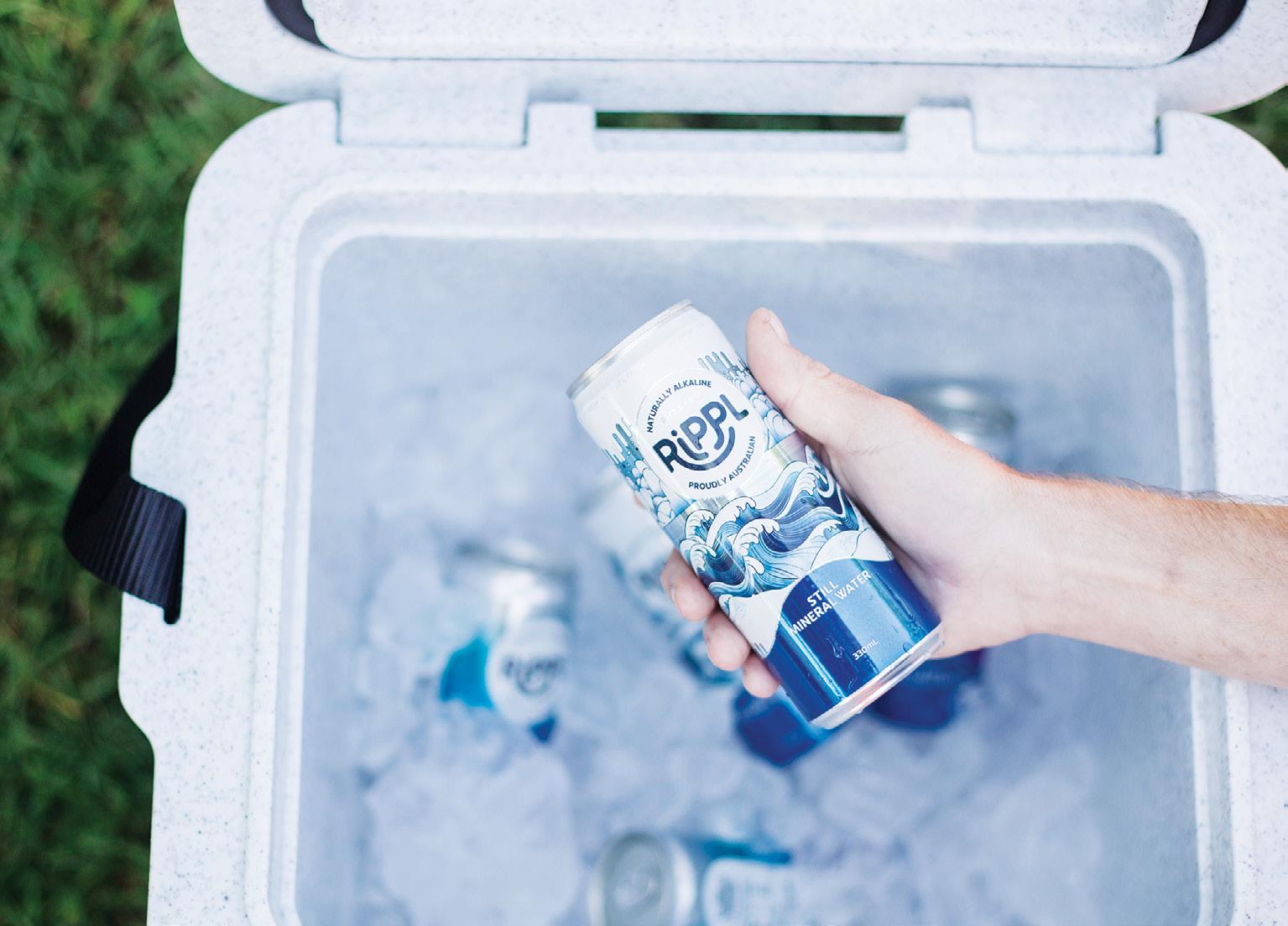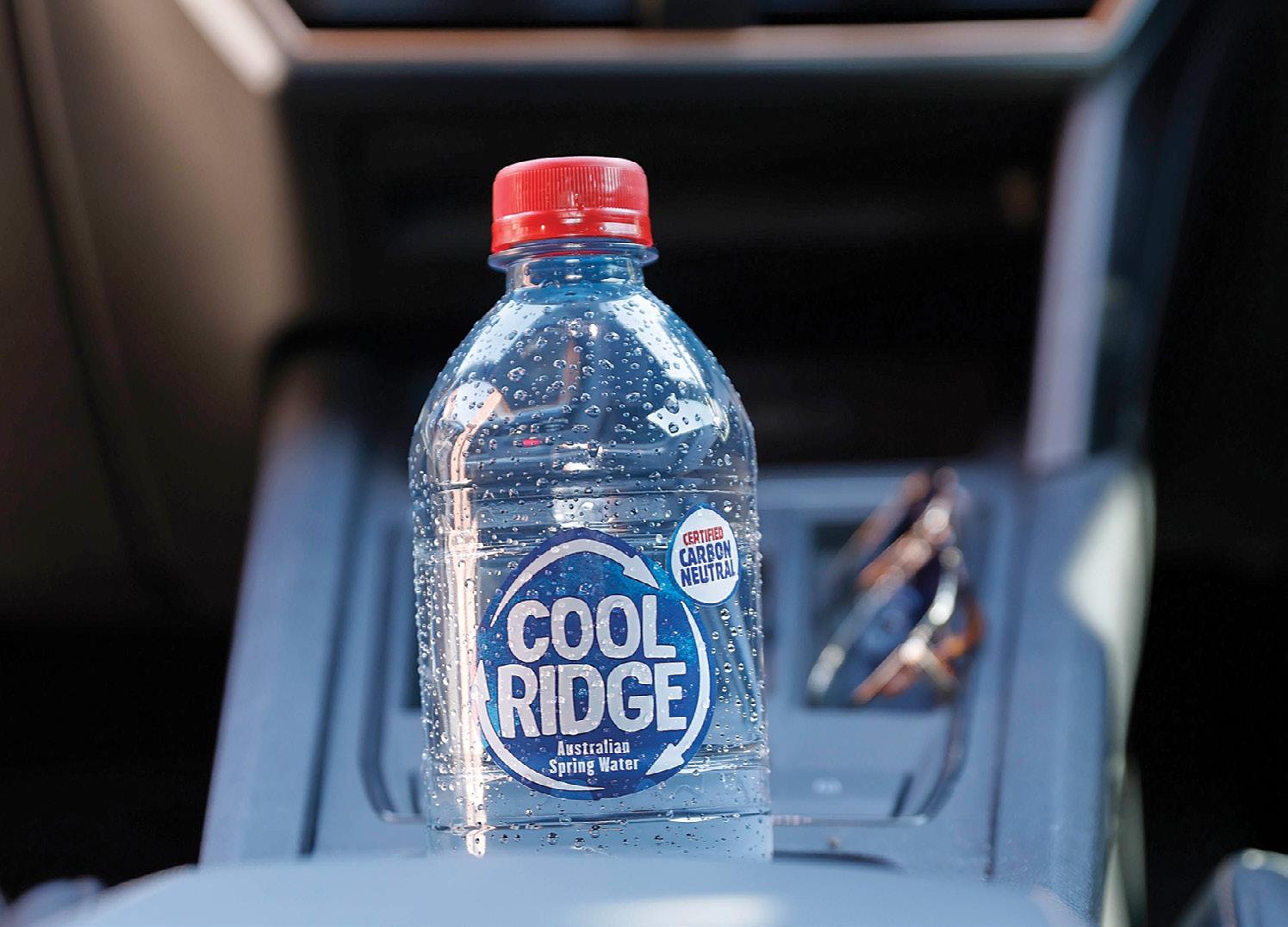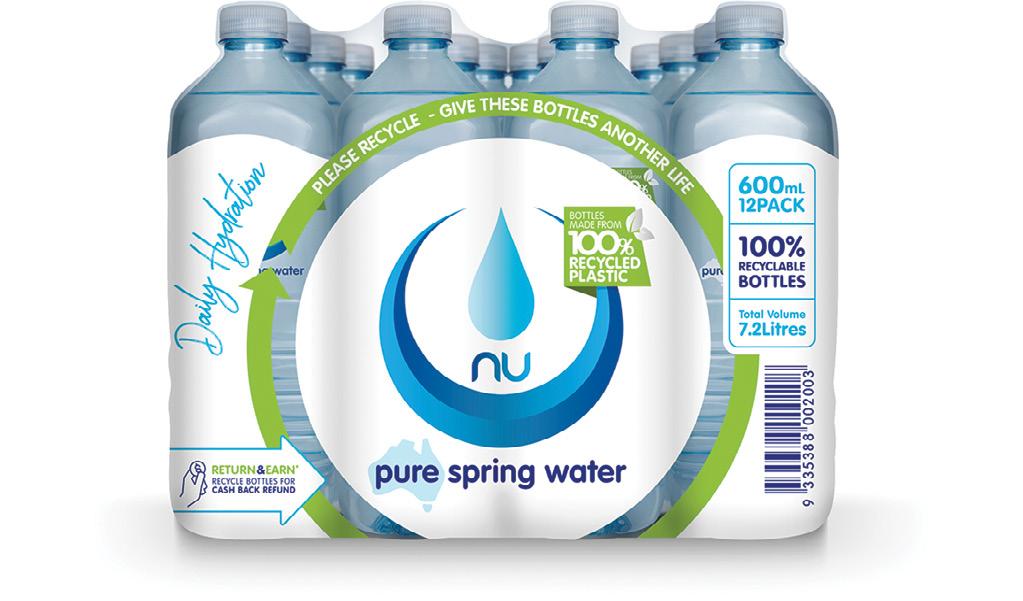
9 minute read
FEATURE: BOTTLED WATER
Hydration evolution
The bottled water market in Australia’s P&C channel is evolving rapidly, with sustainability and health driving future growth and innovation.
IN AUSTRALIA, THE bottled water market within the petrol and convenience channel has experienced significant shifts in recent years, driven by evolving consumer preferences, innovative marketing strategies, and dynamic industry trends.
Over the past three years, the Packaged Beverages category has grown from $1.96 billion to $2.85 billion with all sub-categories apart from Juice showing growth. This is according to Theo Foukkare, CEO of the Australian Association of Convenience Stores (AACS) and the 2023 AACS State of the Industry Report, which highlighted Bottled Water as the fourth strongest performer in the overall Packaged Beverages category behind Energy Drinks, Soft Drinks, and Flavoured Milk.
Foukkare says that convenience is a key factor in driving beverage choices for busy on-the-go consumers.
“The Packaged Beverages category is well positioned to diversify its offer to meet the ever-changing needs of the consumer with strong growth and innovation in the larger categories,” he says.
“Bottled Water now represents 10.9 per cent of sales within the wider Packaged Beverages category. Strong value growth of $33m has been seen over the past 12 months, making it an important category for P&C retailers.”
The role of the P&C channel
According to David Forde, General Manager of Convenience & Petroleum at Coca-Cola Europacific Partners (CCEP), this channel is crucial for their Mount Franklin and Pump brands.
“Petrol and convenience is where a lot of our innovation happens first,” Forde said, as he noted that the P&C channel often serves as a testing ground for new products before they are introduced on a larger scale.
“CCEP is the number one packaged water supplier in the P&C channel, so it’s important for us to win in this channel for the Mount Franklin and Pump brands, to ensure we’re staying relevant and providing our customers and consumers with the beverages they want,” he said.

For Asahi Beverages, the P&C channel is crucial. It serves as a significant driver of impulse purchases, particularly among younger, more spontaneous consumers.
Within the P&C channel, CCEP and Asahi Beverages dominate fridge space, but there are some smaller brands that are building in popularity, including Alka Power, Nu-Pure, and Rippl.
Over the past year, Alka Power has reported an impressive 51 per cent increase in sales across the P&C channel, with the 1.5 litre bottle emerging as a standout performer due to strong brand loyalty.
Steve Pettaras, Managing Director of Alka Power, says that consumers are increasingly discerning, seeking water that offers not just taste but functional benefits, a trend that has worked in Alka Power’s favour.
Effective marketing strategies, such as scan-down promotions and strategic social media use, have bolstered sales for Alka Power. Looking ahead, Pettaras highlights the need for careful timing in launching new products while advocating against additional government taxes such as the Container Deposit Scheme that could further strain the industry.
Rob Hilton, Founder of Mammoth Brands, echoes this sentiment, saying that it has been a challenge to build the Rippl brand in a market that is dominated by the major players. To balance this, he has built a successful corporate side to the business where they can create small quantity custom water for customers.
“If a retailer wants to produce their own water brand, we can create a small or large quantity for them. So, if they want to produce a small run of 600ml water bottles with their own branding, we are able to produce that for them. It’s not only a promotional item of their branding, but also something they can sell.”
Performance and preferences
The market is increasingly driven by sustainability and health. Consumers are gravitating towards products with eco-friendly packaging and health benefits. Sparkling water flavours have experienced significant dollar growth, while alkaline water is the fastest-growing segment, appealing to those seeking health benefits without added calories.
These trends have been evident at Ampol where bottled water sales have largely been in line with 2023.
“Plain and flavoured sparkling water continues to perform well, while alkaline water is becoming increasingly popular with consumers. Multi-buy initiatives and cross promotions with carbonated soft drinks continue to drive volume,” says an Ampol spokesperson. “Packaging type and recyclability is an emerging trend we’re currently seeing in the category, as new products are introduced in aluminium cans.”
Packaging options have become a major focal point with reusable and eco-friendly bottles gaining popularity. Brands are increasingly adopting materials like biodegradable plastics and recycled PET (rPET) to cater to this demand.
We leverage in-store promotions and geotargeted marketing to enhance brand visibility and connect with our audience.
- Raymond Park, National Business Manager, Nu-Pure Beverages
Notably, CCEP’s Mount Franklin and Pump brands have transitioned their bottles under one litre to 100 per cent recycled plastic. This sustainable approach resonates with environmentally conscious consumers, who are encouraged to recycle these bottles to support a circular economy.
Asahi Beverages is also addressing these concerns through initiatives such as the use of 100 per cent recycled PET (rPET) for their Cool Ridge Still and Sparkling Water bottles. This commitment to sustainability is essential in meeting the increasing consumer preference for environmentally responsible products.
In the P&C channel, the 600ml bottle remains the dominant format, reflecting its convenience for on-the-go hydration. However, Jesse Burns from Asahi Beverages notes an emerging trend: larger SKUs, particularly those 750ml and above, are gaining traction.

However, challenges loom as cost-of-living pressures impact consumer behaviour. The P&C channel must adapt by offering competitive pricing to sustain impulse purchases. Retailers are responding by implementing aggressive pricing strategies and bulk purchase options to draw consumers.
Raymond Park, National Business Manager at Nu-Pure Beverages, says the P&C channel remains crucial for Nu-Pure, providing a platform to highlight their dedication to sustainability and convenience.
“We leverage in-store promotions and geotargeted marketing to enhance brand visibility and connect with our audience,” he says.
Looking ahead, Nu-Pure is poised to introduce innovative products aligned with emerging consumer trends. Park hints at an exciting new product launch in the coming months, reflecting their commitment to meeting evolving consumer preferences.
When it comes to innovative packaging, Mammoth Brands is a unique player within the bottled water space, with 330ml naturally alkaline sparkling mineral water brand Rippl and its licensed 400ml re-usable Star Wars still mineral water currently available through 7-Eleven stores nationally.

With exclusive rights to several popular licenses, including Minions, Disney, Star Wars, and Hello Kitty, just to name a few, the naturally alkaline water is proving to be popular with consumers.
“What we’re trying to do is to educate people that you can drink our beautiful, locally sourced, high alkaline Rippl water, which is so good for you, but then you can re-use the bottle over and over again, which is better for the environment. And at the price point that they are, it’s a very attractive offer,” says Hilton.
“We’re really trying to promote that re-use, reuse, re-use and then you can recycle when you’re ready to dispose of it. But because the artwork is so beautiful on our products, we’re finding that people just keep them and put them on their shelves as a collectable.”
Hilton notes that while re-usable water bottles are in their infancy here in Australia, they have been gaining momentum in countries like the US where plastic bottles have been banned in a lot of places.
Later this year, Hilton says the licensed bottles will also be launching in a 600ml format, catering to the growing trend for larger pack sizes.
Emerging trends
Consumers are increasingly gravitating towards products with added health benefits such as electrolytes, vitamins, and minerals. Sparkling water is also gaining popularity as a healthier alternative to sugary beverages. CCEP’s commitment to reducing sugar in its products aligns with this shift, as nearly 50 per cent of their non-alcoholic ready-to-drink portfolio now features low or no sugar options.

Over at Asahi Beverages, Burns has also noticed an increase in interest in functional water products. Consumers are increasingly seeking waters that offer more than basic hydration. Functional waters that provide additional benefits, such as electrolyte replenishment or added vitamins and minerals, are becoming more popular. This trend mirrors global movements, where functional and enhanced waters have already made substantial inroads in markets like the UK, EU, and the US.
“While not mainstream in Australia yet, we are seeing a shift towards functional and vitaminenriched waters,” he says. “Additionally, flavoured waters continue to grow in popularity among consumers seeking variety in their hydration choices.”
Innovations and future outlook
The future outlook for bottled water in the P&C channel points towards a continued emphasis on sustainability and functional benefits.
The growing interest in still, sparkling, and flavoured waters suggests a dynamic market with ample opportunities for new product developments.
CCEP’s Forde highlights that the focus will remain on meeting consumer needs while adapting to industry trends and preferences.
As consumers increasingly prioritise eco-friendly products, brands must stay ahead of these expectations to maintain relevance. Asahi Beverages is preparing for these changes by focusing on sustainable packaging solutions and reducing their carbon footprint. Their Cool Ridge range, certified carbon neutral by Climate Active, exemplifies this commitment.
Overall, the bottled water market in Australia’s P&C channel is evolving rapidly, with sustainability and health driving future growth and innovation.
Retailer strategies:
Strategic placement and visibility:
Retailers in the petrol and convenience sectors strategically place bottled water in high-traffic areas, such as near checkout counters and at eye level, to encourage impulse purchases. This placement maximises visibility and capitalises on consumer convenience.
Promotions and discounts:
Price promotions, bundle offers, and loyalty programs are commonly used by retailers to boost bottled water sales.
For example, offering discounts on multi-pack purchases or combining water with other popular products can drive higher sales volumes and attract budget-conscious consumers.
Seasonal and event-based marketing:
Retailers often leverage seasonal trends and local events to promote bottled water. During peak summer months or major sporting events, special displays and promotions are used to tap into increased demand for hydration solutions.
Fast facts
Bottled Water now represents 10.9 per cent of sales within the wider Packaged Beverages category. Strong value growth of $33 million has been seen in Bottled Water over the past 12 months.




